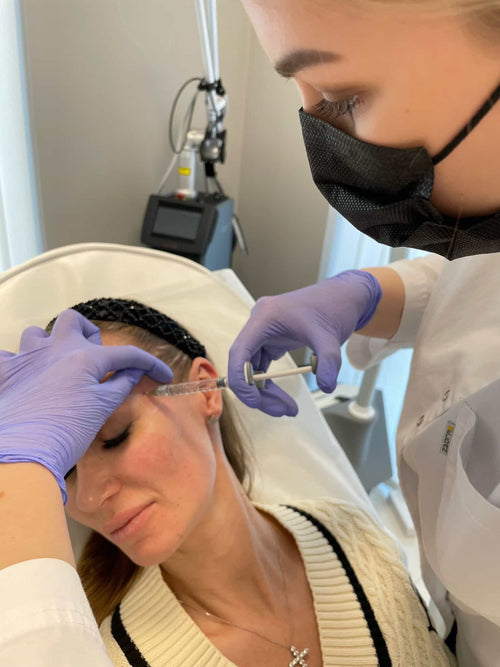What Makes Lip Filler Swelling Go Down
Dermal FillersBook a Dermal Filler Consultation with Dr. Laura Geige at It’s Me and You Clinic
## Time’s Up: Natural Swelling Reduction

The swelling after lip filler injections is a natural part of the healing process. Your body reacts to the hyaluronic acid in fillers by triggering inflammation, leading to temporary puffiness and swelling.
This response involves several stages:
-
Immediate Swelling (0-24 Hours): You’ll likely notice the most significant swelling right after the procedure. It’s often described as a “full” or “plump” sensation.
-
Moderate Swelling (1-3 Days): Over the first few days, swelling gradually subsides but may still be noticeable.
-
Reduced Swelling (3-7 Days): By the end of the week, most swelling should have resolved. You’ll start to see the final shape of your lips emerge.
Several factors can influence the duration and severity of swelling:
-
Amount of Filler Used: Larger volumes will generally cause more initial swelling.
-
Individual Healing Rate: Some people naturally heal faster than others.
-
Lifestyle and Habits: Smoking, alcohol consumption, and lack of sleep can prolong swelling.

Book a Dermal Filler Session with Dr. Laura Geige at It’s Me and You Clinic
While most swelling subsides within a week, it’s important to follow your injector’s post-procedure instructions carefully. This may include:
-
Avoid strenuous activity and heat for the first few days.
-
Elevate your head while sleeping to minimize fluid retention.
-
Apply cold compresses to reduce inflammation.
In rare cases, persistent or unusual swelling may indicate a complication. Consult your injector immediately if you experience any of the following:
-
Excessive pain or tenderness
-
Signs of infection (redness, warmth, discharge)
-
Numbness or tingling that persists beyond a few days
Immediate Aftermath
The First 24-72 Hours
Beyond the Initial Days
## Ice It Out!
After the initial days following lip filler injections, swelling typically subsides gradually over several days to a week.
“Ice it out!” becomes a common piece of advice during this period, and there’s good reason behind it.
Applying ice packs to the treated area can help minimize inflammation by constricting blood vessels and reducing blood flow. This can lead to less swelling and discomfort.
The key is to apply ice for short periods (15-20 minutes) several times a day, always wrapped in a thin cloth to avoid direct contact with the skin.
Remember, excessive ice application can damage the delicate skin of your lips, so moderation is key.
Following the injector’s post-procedure instructions meticulously is crucial for optimal results and minimizing complications like swelling. This might include advice on elevating your head while sleeping to reduce fluid buildup.
Cold Compresses for Relief
Keeping Things Calm
Lip filler swelling is a common side effect that usually subsides within a few days.
While you wait for the swelling to naturally decrease, there are several things you can do to help alleviate discomfort and speed up the healing process.
One of the most effective methods is using cold compresses.
Here’s why cold compresses work and how to use them correctly:
-
vasoconstriction: Cold temperatures constrict blood vessels, reducing inflammation and swelling.
-
Numbness: The coldness can also temporarily numb the area, providing relief from any soreness or tenderness.
To apply a cold compress:
-
Wrap a few ice cubes in a thin cloth or use a pre-made cold compress pack.
-
Apply it to your lips for 10-15 minutes at a time, several times a day.
-
Avoid applying the ice directly to your skin to prevent frostbite.
Remember to take breaks between applications and discontinue use if you experience any discomfort or worsening of symptoms.
In addition to cold compresses, other tips for managing lip filler swelling include:
-
Elevate your head: Sleeping with your head elevated can help reduce fluid buildup in your face.
-
Stay hydrated: Drinking plenty of water helps flush out toxins and promotes healing.
-
Avoid touching or rubbing your lips: This can irritate the area and delay healing.
-
Follow your injector’s instructions carefully: They may have specific recommendations for managing swelling after your treatment.
If you have any concerns about excessive or prolonged swelling, consult your injector or a healthcare professional.
Gentle Massaging Techniques
Avoiding Intense Activity and Sun Exposure
Time is a Healer
Lip filler swelling is a common side effect that typically subsides within a few days to a week. However, there are certain steps you can take to minimize swelling and promote faster healing.
**Avoiding intense activity** immediately after getting lip fillers is crucial. Exercise increases blood flow and can exacerbate swelling.
Stick to light activities like walking for the first few days, and gradually increase your activity level as you feel comfortable.
Similarly, **limit sun exposure**. UV rays can irritate the treated area and potentially delay healing. Wear a broad-spectrum sunscreen with an SPF of 30 or higher on your lips, even on cloudy days.
Remember that ***time is a healer***. Your body will naturally break down any excess filler over time, gradually reducing swelling.
Patience is key during the healing process. Avoid picking or touching your lips excessively, as this can introduce bacteria and cause infection.
Gradual Resolution Over Time
My Mental Health Rocks A Glossy Life Blog Market Day ME Democracy Defense Coalition
- Alluzience Longer Lasting Botox Near Pirbright, Surrey - April 16, 2025
- Why More People Are Switching To THC Beverages - April 12, 2025
- Upper Face Anti Wrinkle Treatment Near Compton, Surrey - January 5, 2025
